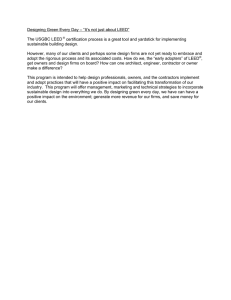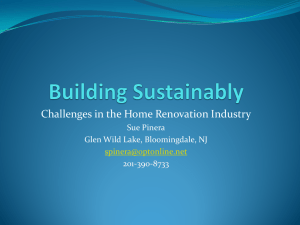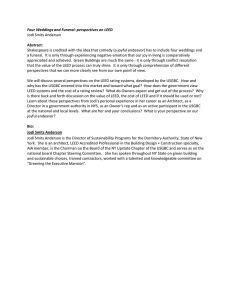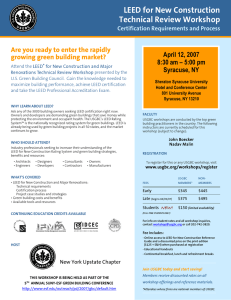www.the-bac.edu / green Fall 2010: Session One
advertisement
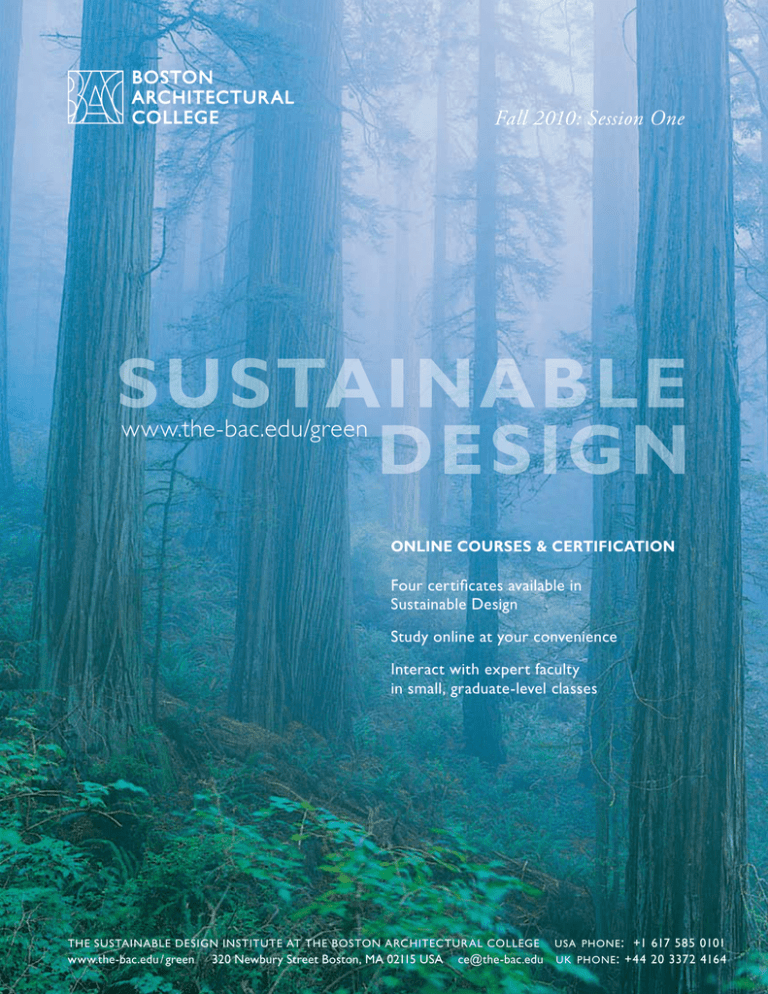
Fall 2010: Session One www.the-bac.edu / green Online courses & certification Four certificates available in Sustainable Design Study online at your convenience Interact with expert faculty in small, graduate-level classes usa phone : +1 617 585 0101 12 www.the-bac.edu / green 320 Newbury Street Boston, MA 02115 USA ce@the-bac.edu uk phone : +44 20 3372 4164 THE SUSTAINABLE DESIGN INSTITUTE AT THE BOSTON ARCHITECTUR AL COLLEGE www.the-bac.edu / green Sustainable Design Certificates The Graduate Certificates in Sustainable Design are earned by completing six courses in a certificate program with a cumulative B- average. A bachelor’s degree is required for enrollment in all of the sustainable design certificates. Students who do not have a bachelor’s degree should contact the Continuing Education department at ce@the-bac.edu or (617) 585-0101 for details on how to apply for admission to the program. Sustainable Design Sustainable Design as a Way of Thinking The Urgent and Hopeful Future of Sustainable Design Four courses from the full Sustainable Design curriculum Sustainable Communit y Pl anning & Design Sustainable Design as a Way of Thinking Sustainable Communities: Land Use, Transportation and Planning Two of the following: • Sustainable Transpor tation Sustainable Building Design & Construction • Greening the City Sustainable Design as a Way of Thinking • Legal Issues in Sustainable Design: from Building to City Scale Three of the following: Two courses from the full Sustainable Design curriculum • The Urgent and Hopeful Future of Sustainable Design • Sustainable Neighborhoods • Green Practice: Energy and Air Quality Principles Sustainable Residential Design • Environmental Systems Sustainable Design as a Way of Thinking • Building Envelope • Site Design, Landscaping and Site-Water Issues • Daylighting and State-of-the-Ar t Electric Lighting • Materials, Resources and Indoor Environmental Quality • Getting the Green Building You Want: Managing the Construction Process Two courses from the full Sustainable Design curriculum Three of the following • The Zero Energy Home: What, How and If • Green Residential Remodeling and Renovations • Residential Energy Modeling • Site Design, Landscaping and Site-Water Issues Two courses from the full Sustainable Design curriculum 320 Newbury Street Boston, MA 02115 USA ce@the-bac.edu usa phone : +1 617 585 0101 uk phone : +44 20 3372 4164 Sustainable Design Certificates The Online Sustainable Design Program at the BAC The Boston Architectural College (BAC) has offered the Sustainable Design Certificate Program since 2002. Our program is completely online, with graduate-level classes that are small, instructor-led, interactive and asynchronous. Our courses carry college credit, and may be taken individually or applied towards one of our four certificate programs. The program is administered by the Sustainable Design Institute (SDI) at the BAC. Four certificates are available in: • Sustainable Design • Sustainable Community Planning and Design • Sustainable Building Design and Construction • and Sustainable Residential Design To complete a certificate, students must successfully complete six courses. Details of the course requirements for each certificate are available on the program website at www. the-bac.edu / green. With over thirty courses the sustainable design curriculum is the most comprehensive available. The program offers a strong foundation in green building practices and principles in all aspects of the design, creation and operation of the built environment. Students have the opportunity to customize their studies and focus on particular areas of interest. The strength of the sustainable design program is evidenced by the fact that many courses are accepted for AIA Sustainable Design / Health, Safety, Welfare Learning Units, many have been approved as part of the US Green Building Council’s Education Providers Program, and offer continuing education credits for LEED AP’s, and most are accepted by the Royal Institute of British Architects for Continuing Professional Development. The Sustainable Design program was developed in partnership with Building Green, a trusted source of unbiased information for building industry professionals concerned with environmental performance. Our Faculty Institute faculty is made up of experienced sustainable design practitioners and educators, who are experts in their fields. Included are architects, engineers, research professionals, landscape architects, interior designers, planners, green building consultants and authors. What to expect in an online Sustainable Design course The online courses do not have specific meeting times, but are highly interactive. For the duration of an online course, weekly correspondence via email and the discussion forums is required. Courses are eight weeks long and are all instructorled. Materials and assignments are posted on an assigned day / time and are available to students throughout each week. System Requirements To participate in an online course, you need to have access to a computer with a standards compliant browser (the latest free version of Firefox; note that Internet Explorer will not work) and the latest free version of Adobe Reader and Adobe Flash Player. A DSL or Broadband internet connection is required. Please note dialup will not work. For select courses, you may need a computer with a built-in or attached microphone. On or before the first day of classes, you will receive login information via the email address you provided on your registration form. This email will contain all the information you will need to access to the course, including login and links to free downloads of Firefox and Adobe. If you do not receive this email by the first day of class, or within two days of a late registration, contact the Continuing Education Department at (617) 585-0101. Visit www.the-bac.edu /g reen for more information. www.the-bac.edu / green 2 Sustainable Design Complete List of Sustainable Design Courses Offered TM7515 Building Envelope TM7472 Daylighting and State-of-the-Art Electric Lighting TM7379 Energy Modeling in Building Design TM7570 Environmental Systems TM7374 Getting the Green Building You Want: Construction Management TM7247 Global Perspectives on Sustainable Design TM7428 Green Practice: Energy and Air Quality Principles TM7318 Green Residential Remodeling and Renovation TM7319 Green Roofs / Green Walls TM7376 Greening Existing Buildings TM7377 Greening the City TM7710 High Performance Design and the LEED Rating System TM7233 Learning from Sustainable Design Through History HT7521 Legal Issues in Sustainable Design – from the Building to the City Scale TM7349 Life Cycle Assessment of Building Materials TM7615 Marketing Sustainability TM7445 Materials, Resources and Indoor Environmental Quality TM7373 Residential Energy Modeling TM7415 Site Design, Landscaping, and Site-Water Issues TM7314 Solar Energy: Design with the Sun TM7603 Sustainable Communities: Land Use, Transportation, and Planning TM7810 Sustainable Design and Building Information Modeling (BIM) TM7241 Sustainable Design and Preservation HT7520 Sustainable Design as a Way of Thinking TM7715 Sustainable Design in Practice TM7278 Sustainable Design of Healthcare Facilities TM7378 Sustainable Neighborhoods TM7601 Sustainable Transportation TM7154 The Economics of Green Building TM7242 The Urgent and Hopeful Future of Sustainable Design TM7317 The Zero Energy Home: What, How and If 320 Newbury Street Boston, MA 02115 USA ce@the-bac.edu usa phone : +1 617 585 0101 uk phone : +44 20 3372 4164 Fall 2010 Courses Fall 2010: Session One Fall 2010: Session Two August 30 – October 23 FALL REGISTR ATION BEGINS JULY 17 October 25 – December 18 FALL REGISTR ATION BEGINS JULY 17 Building Envelope Prerequisites Environmental Systems Prerequisites Daylighting and State-of-the-Art Electric Lighting Global Perspectives on Sustainable Design Energy Modeling in Building Design Green Practice: Energy and Air Quality Principles Environmental Systems Prerequisites Green Residential Remodeling and Renovation Getting the Green Building You Want: Construction Management Green Roofs / Green Walls Green Practice: Energy and Air Quality Principles Greening the City Life Cycle Assessment of Building Materials High Performance Design and the LEED Rating System Prerequisites Marketing Sustainability Materials, Resources and Indoor Environmental Quality Site Design, Landscaping, and Site-Water Issues Solar Energy: Design with the Sun Greening Existing Buildings Learning from Sustainable Design through History Legal Issues in Sustainable Design: from the Building to the City Scale Materials, Resources and Indoor Environmental Quality Sustainable Communities: Land Use, Transportation, and Planning Sustainable Design as a Way of Thinking Sustainable Design in Practice Prerequisites Sustainable Design of Healthcare Facilities The Urgent and Hopeful Future of Sustainable Design Residential Energy Modeling Sustainable Design as a Way of Thinking Sustainable Neighborhoods Sustainable Transportation The Economics of Green Building The Zero Energy Home: What, How and If Tuition (per course) This brochure is published periodically as a reference guide to Sustainable Design courses; the policies and schedule are subject to change. Visit www.the-bac.edu for current information. EDUCATION PROVIDER Certificate Credit $1,380 Audit $950 Many of our online, instructor-led courses are part of the Royal Institute of British Architects Continuing Professional Development (CPD) Providers Network, approved for HSW / Sustainable Design Learning Units by the American Institute of Architects, and/or are approved by the USGBC for GBCI CE Hours for LEED professionals. The courses have been developed in partnership with BuildingGreen, providers of authoritative information on sustainable design and construction since 1985. www.the-bac.edu / green 4 Sustainable Design BUILDING ENVELOPE 1.5 Credits ∙ 24 AIA HSW / SD ∙ 48 GBCI CE Hrs RIBA CPD-approved ∙ USGBC Education Providers Level 300 ∙ Prerequisites: Sustainable Design as a Way of Thinking, or equivalent knowledge in sustainable design. Peter Yost is with BuildingGreen, LLC. He has been building, researching, teaching, writing, and consulting on high performance homes for more than twenty years. Jim Newman is an architect who currently works for Building Green. He is vice-chair of the Board of the USGBC Massachusetts Chapter and has fifteen years experience as a principal in a Boston-based design and construction firm. photo courtesy of Genzyme Corporation The Atrium at Genzyme Corporation Headquarters in Cambridge, MA is in one of the first LEED Platinum office buildings in the country It is the building enclosure where many sustainable design intentions find their physical expression. Here, as well, is where the majority of legal claims against designers find their expression. The building enclosure has three major assemblies-foundation, walls, and roof, each with as many as ten or more components. Sustainable design requires integration of these assemblies and their components in a way that manages the major degradation vectors- water, air, heat, radiation, pests, and even occupants. This course covers the building enclosures for both commercial and residential structures. A major focus of the course is the relationships among green building, building science, energy efficiency, durability, and risk management. Students leave the course with a new way of understanding, analyzing, and designing sustainable enclosures. An equal emphasis is placed on design, specification, construction, and commissioning of building enclosures. DAYLIGHTING & STATE-OF-THE-ART ELECTRIC LIGHTING 1.5 Credits• RIBA CPD-approved Will Lewis has designed both natural and artificial lighting environments for a wide range of project types including hospitality, residential, retail, corporate interiors, museums, civic, and streetscapes. His work has been recognized with multiple IIDA Awards of Merit. This course will examine the techniques and benefits of daylighting in terms of occupants’ well being and productivity, potential improvements in energy efficiency, and its effects on building form. For daylighting, the relative advantages and disadvantages of toplighting versus sidelighting and the best approaches to the design of both will be covered. The course will also examine the latest approaches to the design of efficient electric lighting both 320 Newbury Street Boston, MA 02115 USA ce@the-bac.edu usa phone : +1 617 585 0101 uk phone : +44 20 3372 4164 Fall 2010: Session One Courses inside and outside of buildings. The plusses and minuses of different kinds of lamps and fixtures along with issues of efficiency, light quality, longevity and disposal will be considered. ENERGY MODELING IN BUILDING DESIGN (COMMERCIAL) 1.5 Credits Mike Andelman has thirty years experience in HVAC system design and energy modeling. He has conducted a number of energy modeling training sessions for engineers and architects over the past ten years. He holds a PE license in Massachusetts and Pennsylvania. With the development of increasingly sophisticated software, energy modeling has become an integral part of commercial and institutional building design. Making energy performance a manipulable element at the earliest stages of building design is essential to sustainable building design. This course will provide an overview of energy modeling of commercial and institutional buildings, an introduction to the most popular energy modeling packages, including hands-on experience with at least one of them, and a discussion of how to make use of energy modeling results in the design process. The relationship of energy modeling to green building rating systems will also be explored. Environmental Systems 1.5 Credits ∙ 24 AIA HSW / SD LUs ∙ 48 GBCI CE Hrs ∙ RIBA CPD-approved ∙ USGBC Education Providers Level 400 ∙ Prerequisite: Green Practice: Energy and Air Quality Principles. Tom Kelly is a mechanical engineer and the Senior Project Manager for Training at Carrier Corporation. He has served on the Professional Development Committee for the USGBC and in on ASHRAE committees for sustainability, air-toair heat recovery and gas phase filtration. Tom has done significant studies on indoor air quality for Syracuse University. Designed as a follow-up course to Energy and Air Quality Principles, this course covers environmental systems fundamentals, HVAC system types, ventilation requirements, demand-controlled and energy recovery ventilation, underfloor-air systems, air distribution, fuel choices, understanding energy efficiency, zero-energy buildings, renewable energy systems, solar thermal systems, building-integrated photovoltaics, biofuels, energy modeling, and plumbing / water conservation. Getting the Green Building You Want: Construction Management 1.5 Credits ∙ RIBA CPD-approved ∙ 48 GBCI CE Hrs ∙ USGBC Education Providers Level 300 George Psaledakis is an architect with extensive experience in construction management, including LEED projects. The plans and specifications for your green building have been completed, a contract has been awarded and now you are ready to implement the documents. Are you ready for the reality that all the careful planning and foresight will require more finesse and oversight during construction? The current methods of construction and traditional attitudes in the construction industry could impose its “business as usual” processes. This course will examine the cultural nuances, the construction intricacies, documentation and commissioning hurdles to implement the “green” documents and how you can assure your project will meet the goals originally planned for to achieve your energy efficient and environmentally sound construction project. Green pr actice: Energy & air quality principles 1.5 Credits ∙ 24 AIA HSW / SD LUs ∙ 48 GBCI CE Hrs ∙ RIBA CPDapproved ∙ USGBC Education Providers Level 300 John H. Boehs Jr., LEED AP is a mechanical engineer with more than ten years of experience in the design of energyconscious buildings. Most recently, John was employed as a senior mechanical engineer with the Boston office of Arup. Michelle Lambert is an architect for ADD Inc. in Boston where she chairs their internal Environmental Task Force. Her professional experience includes architecture, urban planning, green building consulting and building science research. The concept of an environmentally conscious building should take into account energy consumption, the quality of indoor air, and most importantly human comfort. Indigenous strategies that adapt to the rigors of the local climate and contemporary bioclimatic architecture are part of this introductory course to sustainable design. Participants will be introduced to the human needs for comfort and shelter as well as psychrometrics and the physics of heat transfer and heat loss calculations. Building form, orientation, and indoor spaces will also be discussed as they relate to sun, wind, and site, as well as bioclimatic design, passive solar design, natural cooling, and daylighting. www.the-bac.edu / green 6 Sustainable Design LIFE CYCLE ASSESSMENT OF BUILDING MATERIALS 1.5 Credits Anne Nicklin is a sustainability consultant with Davis Langdon where she has been actively involved in the life cycle analysis team. She is a LEED Accredited Professional and has earned an MArch from Pratt Institute. This course will provide students with a comprehensive understanding of the Life Cycle Assessment of building materials, from energy associated with the harvest and manufacture of building materials to how material pricing, historical supply, and socioeconomic factors contribute to the total value of an item. Building on the Materials, Resources and IEQ introductory course, students will learn different methods of accounting for the impact of extraction, manufacture, shipping, installation and disposal / recycling / reuse of a material. Students will create case studies emphasizing a triple bottom line approach in evaluating the environmental, economic, and ethical impact of different materials. The coursework will review existing tools and standards such as ISO 14040, Cradle to Cradle and SimaPro as well as input from industry experts on the rapidly evolving field of life cycle analysis. 320 Newbury Street Boston, MA 02115 USA ce@the-bac.edu MARKETING SUSTAINABILITY 1.5 Credits ∙ 48 GBCI CE Hrs ∙ RIBA CPD-approved ∙ USGBC Education Providers Level 300 ∙ Prerequisites: Sustainable Design as a Way of Thinking, or equivalent knowledge in sustainable design. Elizabeth Meek, IIDA, LEED AP is a Principal at Sasaki Associates, where she leads teams in tenant fit-up projects. She develops strategic and tactical marketing plans for the commercial market. This course offers an introduction to green building marketing. Students will be introduced to the current market for green buildings, to marketing concepts and projected future growth rates under various scenarios. The course introduces marketing concepts for professional service firms, including architects and designers, engineers and contractors. Finally, the course examines concepts of personal and firm branding to allow the individual and firm to differentiate their offerings, reinforce their positioning message and respond to the fast-changing market. usa phone : +1 617 585 0101 uk phone : +44 20 3372 4164 Fall 2010: Session One Courses Materials, resources, & indoor environmental quality SITE DESIGN, LANDSCAPING & SITE-WATER ISSUES 1.5 Credits ∙ 24 AIA HSW / SD LUs ∙ 48 GBCI CE Hrs ∙ RIBA CPDapproved ∙ USGBC Education Providers Level 300 1.5 Credits ∙ 24 AIA HSW / SD LUs ∙ 48 GBCI CE Hrs ∙ RIBA CPDapproved ∙ USGBC Education Providers Level 300 Marjorie “Margie” McNally, LEED AP is a licensed interior designer and environmental consultant specializing in sustainable design, healthy interiors and energy efficient lighting design. Beth Paulson is a landscape designer, who promotes the use of Ecology and Plant Community Models in her work with private clients and design firms. This course gives students the tools they need to evaluate a material based on how it impacts the built and natural environment. Since people in western cultures tend to spend most of their time indoors, specific attention will be paid to Indoor Environmental Quality (IEQ). Environmentally responsible materials selection will be discussed, including the importance of waste, Life Cycle Assessment (LCA), and all aspects of the manufacturing process. Interior design issues that are covered include the importance of natural daylighting, Indoor Air Quality (IAQ), and acoustics. Current materials rating systems and specification writing aids will be reviewed. Case studies representing best practices in sustainable design of interiors will be presented for discussion. This course is directly useful to anyone selecting materials for any kind of building project. Structures are sustainably sited based on an assessment of site specific climatic and natural conditions. An understanding of the geologic, hydrologic, and ecosystem processes, as well as regional climate, and site-specific microclimates, is the foundation upon which sustainable planning and design are based. This course will introduce principles, practices, materials and methods that allow the realization of responsible solutions in today’s burgeoning green marketplace. Students will explore the role that architects and other design team professionals share in generating sustainable site design as site elements are used to increase comfort levels, and lower energy use and operating costs. In green practice, the site’s climatic and environmental features directly influence form and location as architectural design moves beyond the building envelope and into the landscape. SOLAR ENERGY: DESIGN WITH THE SUN 1.5 Credits ∙ 48 GBCI CE Hrs ∙ RIBA CPD-approved ∙ USGBC Education Providers Level 300 Troy Peters is a registered architect and an Assistant Professor in the Architecture Department at California Polytechnic State University. He is the author of several software programs for passive solar calculations and daylighting. The Wind Farm at Altamont Pass, CA has been supplying renewable energy for decades. The interaction of buildings and sunlight is rich and complex. This course will examine the many possibilities provided by the sun to power, light and heat our buildings. These possibilities are affected by geographic location, climate, building site, and building form, orientation, fenestration and thermal mass–all of which will be considered. Passive and active solar thermal systems, solar domestic hot water systems and photovoltaics will be studied along with design strategies to prevent unwanted solar gain in climates and seasons when that is a problem. The relative cost and benefits of different solar strategies will also be addressed. www.the-bac.edu / green 8 Sustainable Design The Sustainable Design Institute at the BAC is located in Boston’s Back Bay, a high-density, mixed-use, pedestrianoriented community. SUSTAINABLE COMMUNITIES: LAND USE, TR ANSPORTATION & PLANNING 1.5 Credits ∙ 24 AIA HSW / SD LUs ∙ RIBA CPD-approved ∙ 48 GBCI CE Hrs ∙ USGBC Education Providers Level 300 Margarita Iglesia is a planner and urban designer with twenty years of experience in the development of livable, attractive and sustainable communities throughout New England. This course examines how communities across the nation are grappling with such smart growth issues as affordable housing, sprawl, urban revitalization, economic development, transportation investments, and open space protection. These issues are also collectively referred to as sustainable development, growth management or New Urbanism. The course will cover the history of sprawl and current policy debates about land use, urban design, regulation, and public and private investment. The course will feature critiques of specific development projects, tailored to the interests and communities of students. Sustainable Design as a Way of Thinking 1.5 Credits ∙ 24 AIA HSW / SD LUs ∙ 48 GBCI CE Hrs ∙ RIBA CPD-approved ∙ USGBC Education Providers Level 300 David Foley has worked in the fields of energy efficiency and environmental building since 1980, as a designer, builder, teacher and researcher. Dr Elena Douvlou Elena is an architect and has taught and published on the subjects of sustainable design, bioclimatic architecture, thermal comfort and post occupancy evaluation. This course traces the history of the sustainable design movement then introduces its primary tenets using the LEED Rating System as the organizing structure. Readings in the course are drawn largely from Environmental Building News. Online discussions are designed to acquaint the students with the language, philosophy, and principles of sustainable design. This course examines the underlying principles of sustainability and design. The class focuses on environmental sustainability and thought processes that can help professionals design a more sustainable world. Major aspects of environmental building that will be addressed include energy efficiency, building materials, indoor environmental quality and land use. Ways of evaluating the sustainability of the built environment are discussed including the LEED™ rating system. 320 Newbury Street Boston, MA 02115 USA ce@the-bac.edu SUSTAINABLE DESIGN IN PR ACTICE 1.5 Credits ∙ 24 AIA HSW / SD LUs ∙ 48 GBCI CE Hrs ∙ RIBA CPD-approved ∙ USGBC Education Providers Level 400 Richard Sullivan is an Architect and a Principal in the firm of Sowinski Sullivan Architects, PC in New Jersey, where he directs building design, working on a diverse range of sustainable projects. Effective organization and design process are as essential to green design as technical knowledge. This course will address techniques for mobilizing support for sustainable building among clients, funding sources, sub-consultants and the project team. A variety of strategies will be discussed with regard to integrated design, goal setting, specifications, commissioning, post-occupancy evaluation, LEED certification, construction administration, and policy implications. Resources for further learning will be provided and discussed as well as case studies representing best practices in orchestrating sustainable design projects. Prerequisites: Sustainable Design as a Way of Thinking or equivalent knowledge in sustainable design, and one of the following courses: Green Practice: Energy and Air Quality Principles, Building Envelope, or Materials, Resources and Indoor Environmental Quality. Courses in our Planning track. usa phone : +1 617 585 0101 uk phone : +44 20 3372 4164 Fall 2010: Session One Courses photo courtesy of Bonica Ayala THE URGENT & HOPEFUL FUTURE OF SUSTAINABLE DESIGN SUSTAINABLE DESIGN OF HEALTHCARE FACILITIES 1.5 Credits ∙ 48 GBCI CE Hrs ∙ RIBA CPD-approved ∙ USGBC Education Providers Level 300 1.5 Credits ∙ 48 GBCI CE Hrs ∙ RIBA CPD-approved ∙ 6 EADC CEUs ∙ USGBC Education Providers Level 300 Richard Graves is an architect formerly with Perkins and Will in Minneapolis, where he focused on green building projects. He is Vice President for Community at the US Green Building Council. Mara Baum, AIA, LEED AP is a designer and researcher at Anshen+Allen Architects in San Francisco, specializing in the design of healthcare facilities. She has extensive green building experience. A review of the “cutting edge” of sustainable design including the evolution of mindset, processes and tools required for a sustainable future. Active engagement with the processes and systems of the living world yields: an understanding of wise action, the development of an aesthetic of beauty born from a unity of mind and nature, and the expansion of the context of design beyond the individual building. Examples include: Systems Theory, Integrated Design, Triple Bottom Line, the Precautionary Principle (mindset and process), and LEED 2030 Challenge, Living Building Challenge, Permaculture, Biomimicry, Life-cycle analysis and Eco-Charrettes (tools). Greening healthcare projects should be a no brainer -what building type has occupants more deserving of a healthy space? Unfortunately, When people think of healthy spaces, hospitals are often among the last to come to mind. The intense resource requirements, code constraints, and programmatic requirements and institutional culture can make green building a more significant challenge than with other typologies. This course explores theories and practices of sustainable healthcare design, what it means to create a healthy and healing environment, and how to balance the complex demands of hospitals with those of environmental issues. Topics will include energy and water use intensity, toxicities in building materials, daylighting and opportunities for connections to nature, greening a healthcare campus, use of rating systems, and more. The class will be broken into weekly units with readings, discussions and assignments or quizzes. www.the-bac.edu / green 10
